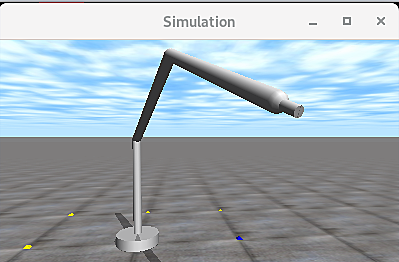プログラミング/IoT の関連商品 (Amazonのアソシエイトとして、当メディアは適格販売により収入を得ています。)
最近の投稿
概要
ロボットアームは複数のリンクがジョイントで結合されており、先端にマニピュレータが存在します。Open Dynamics Engine (ODE) を用いたシミュレーションを行い、ジョイントの関節値とマニピュレータの位置姿勢の関係を把握します。
順運動学によるマニピュレータの位置姿勢の計算
回転行列と回転ベクトルの変換のために以下のパッケージを利用しています。
pip install scipy
3 自由度ロボットアームについて、関節値を指定したときのマニピュレータの位置姿勢の計算は以下のようになります。変換行列による座標変換を利用して計算したマニピュレータの位置姿勢と、ODE の機能を利用して取得したマニピュレータの位置姿勢が一致することを確認します。ジョイント値の制御には PD 制御を用いています。
#!/usr/bin/python
# -*- coding: utf-8 -*-
import odepy
import drawstuffpy as ds
import ctypes
import numpy as np
from sys import version_info
from scipy.spatial.transform import Rotation
def Main():
world, space, ground, contactgroup = CreateWorld()
# 3 自由度ロボットアーム
robot = Robot(world, space)
def __StepCallback(pause):
# 関節値の PD 制御
tDelta = 0.01
robot.Control(tDelta)
# 理想的なセンサで取得した値
posManip = robot.GetManipPos()
rotManip = robot.GetManipRot()
# 順運動学で導出した値
posManip2 = robot.GetManipPos2()
rotManip2 = robot.GetManipRot2()
eps = 1e-1
for i in range(3):
assert(abs(posManip2[i] - posManip[i]) < eps)
assert(abs(rotManip2[i] - rotManip[i]) < eps)
odepy.dWorldStep(world, tDelta)
odepy.dJointGroupEmpty(contactgroup)
for geom in robot.GetGeoms():
r = odepy.dReal()
l = odepy.dReal()
if odepy.dGeomGetClass(geom) == odepy.dCylinderClass:
odepy.dGeomCylinderGetParams(geom, ctypes.byref(r), ctypes.byref(l))
ds.dsDrawCylinderD(odepy.dGeomGetPosition(geom), odepy.dGeomGetRotation(geom), l.value, r.value)
if odepy.dGeomGetClass(geom) == odepy.dCapsuleClass:
odepy.dGeomCapsuleGetParams(geom, ctypes.byref(r), ctypes.byref(l))
ds.dsDrawCapsuleD(odepy.dGeomGetPosition(geom), odepy.dGeomGetRotation(geom), l.value, r.value)
def __Command(cmd):
jointValues = robot.GetJointValues()
if chr(cmd) == 'a':
jointValues[0] += 0.1
if chr(cmd) == 'A':
jointValues[0] -= 0.1
if chr(cmd) == 'b':
jointValues[1] += 0.1
if chr(cmd) == 'B':
jointValues[1] -= 0.1
if chr(cmd) == 'c':
jointValues[2] += 0.1
if chr(cmd) == 'C':
jointValues[2] -= 0.1
robot.SetJointValues(jointValues)
RunDrawStuff(__StepCallback, __Command)
DestroyWorld(world, space)
class Robot(object):
def __init__(self, world, space):
q = odepy.dQuaternion()
odepy.dQFromAxisAndAngle(q, 0, 0, 1, 0.0)
lBase = 0.10
l1 = 0.90
l2 = 1.0
l3 = 1.0
lManip = 0.10
# ジオメトリの作成
self.__base = self.__AddCylinder(world, space, r=0.20, l=lBase, m=9.0, px=0.0, py=0.0, pz=(lBase / 2.0), q=q)
self.__link1 = self.__AddCapsule(world, space, r=0.04, l=l1, m=2.0, px=0.0, py=0.0, pz=(lBase + l1 / 2.0), q=q)
self.__link2 = self.__AddCapsule(world, space, r=0.04, l=l2, m=2.0, px=0.0, py=0.0, pz=(lBase + l1 + l2 / 2.0), q=q)
self.__link3 = self.__AddCapsule(world, space, r=0.04, l=l3, m=2.0, px=0.0, py=0.0, pz=(lBase + l1 + l2 + l3 / 2.0), q=q)
self.__manip = self.__AddCylinder(world, space, r=0.02, l=lManip, m=0.5, px=0.0, py=0.0, pz=(lBase + l1 + l2 + l3 + lManip / 2.0), q=q)
# 地面に固定します。
self.__jointBase = odepy.dJointCreateFixed(world, 0)
odepy.dJointAttach(self.__jointBase, odepy.dGeomGetBody(self.__base), 0)
odepy.dJointSetFixed(self.__jointBase)
self.__joint1 = self.__AddJoint(world, odepy.dGeomGetBody(self.__base), odepy.dGeomGetBody(self.__link1), [0.0, 0.0, lBase], [0, 0, 1])
self.__joint2 = self.__AddJoint(world, odepy.dGeomGetBody(self.__link1), odepy.dGeomGetBody(self.__link2), [0.0, 0.0, lBase + l1], [0, 1, 0])
self.__joint3 = self.__AddJoint(world, odepy.dGeomGetBody(self.__link2), odepy.dGeomGetBody(self.__link3), [0.0, 0.0, lBase + l1 + l2], [0, 1, 0])
# マニピュレータ
self.__jointManip = odepy.dJointCreateFixed(world, 0)
odepy.dJointAttach(self.__jointManip, odepy.dGeomGetBody(self.__link3), odepy.dGeomGetBody(self.__manip))
odepy.dJointSetFixed(self.__jointManip)
# 目標値となるジョイント値、およびその残差
self.__jointValues = [-1.0, -1.0, -1.0]
self.__eJointValues = [0.0, 0.0, 0.0]
def GetManipPos(self):
# マニピュレータの位置を ODE の機能を利用して取得して返します。
posOde = odepy.dGeomGetPosition(self.__manip)
pos = np.zeros(3, dtype=np.float)
for i in range(len(pos)):
pos[i] = posOde[i]
return pos
def GetManipRot(self):
# マニピュレータの姿勢を ODE の機能を利用して取得して返します。
rotOde = odepy.dGeomGetRotation(self.__manip)
rot = np.zeros(12, dtype=np.float)
for i in range(len(rot)):
rot[i] = rotOde[i]
rot = rot.reshape(3, 4)[:3, :3]
if version_info.major < 3:
rotVec = Rotation.from_dcm(rot).as_rotvec()
else:
rotVec = Rotation.from_matrix(rot).as_rotvec()
return rotVec
def GetManipPos2(self):
# 変換行列によるマニピュレータの位置計算
tManipToWorld = self.__GetTransformManipToWorld()
pos = np.array([[0, 0, 0, 1]], dtype=np.float).T
pos = tManipToWorld.dot(pos)
pos = pos.reshape(1, 4)[0][:3]
return pos
def GetManipRot2(self):
# 変換行列によるマニピュレータの姿勢計算
tManipToWorld = self.__GetTransformManipToWorld()
if version_info.major < 3:
rot = Rotation.from_dcm(tManipToWorld[:3, :3])
else:
rot = Rotation.from_matrix(tManipToWorld[:3, :3])
rotVec = rot.as_rotvec()
return rotVec
def __GetTransformManipToWorld(self):
# ジョイント値
angle1 = odepy.dJointGetHingeAngle(self.__joint1)
angle2 = odepy.dJointGetHingeAngle(self.__joint2)
angle3 = odepy.dJointGetHingeAngle(self.__joint3)
# 回転ベクトルの計算
rot1 = Rotation.from_rotvec(angle1 * np.array([0, 0, 1]))
rot2 = Rotation.from_rotvec(angle2 * np.array([0, 1, 0]))
rot3 = Rotation.from_rotvec(angle3 * np.array([0, 1, 0]))
# 回転行列に変換
if version_info.major < 3:
rot1 = rot1.as_dcm()
rot2 = rot2.as_dcm()
rot3 = rot3.as_dcm()
else:
rot1 = rot1.as_matrix()
rot2 = rot2.as_matrix()
rot3 = rot3.as_matrix()
# リンクの長さを取得
lBase = odepy.dReal()
l1 = odepy.dReal()
l2 = odepy.dReal()
l3 = odepy.dReal()
lManip = odepy.dReal()
r = odepy.dReal()
odepy.dGeomCylinderGetParams(self.__base, ctypes.byref(r), ctypes.byref(lBase))
odepy.dGeomCylinderGetParams(self.__link1, ctypes.byref(r), ctypes.byref(l1))
odepy.dGeomCylinderGetParams(self.__link2, ctypes.byref(r), ctypes.byref(l2))
odepy.dGeomCylinderGetParams(self.__link3, ctypes.byref(r), ctypes.byref(l3))
odepy.dGeomCylinderGetParams(self.__manip, ctypes.byref(r), ctypes.byref(lManip))
# 変換行列の平行移動部分を計算
trans1 = np.array([0, 0, -(lBase.value + l1.value)], dtype=np.float)
trans2 = np.array([0, 0, -l2.value], dtype=np.float)
trans3 = np.array([0, 0, -(l3.value + lManip.value / 2.0)], dtype=np.float)
# 変換行列として結合
tWorldToLink1 = np.vstack((np.hstack((rot1, trans1.reshape(3, 1))), np.array([0, 0, 0, 1], dtype=np.float)))
tLink1ToLink2 = np.vstack((np.hstack((rot2, trans2.reshape(3, 1))), np.array([0, 0, 0, 1], dtype=np.float)))
tLink2ToManip = np.vstack((np.hstack((rot3, trans3.reshape(3, 1))), np.array([0, 0, 0, 1], dtype=np.float)))
# 逆変換
tLink1ToWorld = np.linalg.inv(tWorldToLink1)
tLink2ToLink1 = np.linalg.inv(tLink1ToLink2)
tManipToLink2 = np.linalg.inv(tLink2ToManip)
# マニピュレータ座標系とワールド座標系の変換行列
tManipToWorld = tLink1ToWorld.dot(tLink2ToLink1).dot(tManipToLink2)
return tManipToWorld
def Control(self, tDelta):
kp = 10.0
kd = 0.9
fMax = 100.0
for i, joint in enumerate([self.__joint1, self.__joint2, self.__joint3]):
jointValue = odepy.dJointGetHingeAngle(joint) # pi と -pi を越える際に不連続です。
eJointValue = self.__jointValues[i] - jointValue
# jointValue が不連続であることに対応して以下の処理を行います。
while eJointValue > np.pi:
eJointValue -= 2.0 * np.pi
while eJointValue < -np.pi:
eJointValue += 2.0 * np.pi
u = kp * eJointValue + kd * (eJointValue - self.__eJointValues[i]) / tDelta
odepy.dJointSetHingeParam(joint, odepy.dParamVel, u)
odepy.dJointSetHingeParam(joint, odepy.dParamFMax, fMax)
self.__eJointValues[i] = eJointValue
def GetJointValues(self):
return self.__jointValues
def SetJointValues(self, jointValues):
self.__jointValues = jointValues
def GetGeoms(self):
return self.__base, self.__link1, self.__link2, self.__link3, self.__manip
def __AddCylinder(self, world, space, r, l, m, px, py, pz, q, direction=3):
geom = odepy.dCreateCylinder(space, r, l)
body = odepy.dBodyCreate(world)
mass = odepy.dMass()
odepy.dMassSetZero(ctypes.byref(mass))
odepy.dMassSetCylinderTotal(ctypes.byref(mass), m, direction, r, l)
odepy.dGeomSetBody(geom, body)
odepy.dBodySetMass(body, ctypes.byref(mass))
odepy.dBodySetPosition(body, px, py, pz)
odepy.dBodySetQuaternion(body, q)
return geom
def __AddCapsule(self, world, space, r, l, m, px, py, pz, q, direction=3):
geom = odepy.dCreateCapsule(space, r, l)
body = odepy.dBodyCreate(world)
mass = odepy.dMass()
odepy.dMassSetZero(ctypes.byref(mass))
odepy.dMassSetCapsuleTotal(ctypes.byref(mass), m, direction, r, l)
odepy.dGeomSetBody(geom, body)
odepy.dBodySetMass(body, ctypes.byref(mass))
odepy.dBodySetPosition(body, px, py, pz)
odepy.dBodySetQuaternion(body, q)
return geom
def __AddJoint(self, world, body1, body2, pos, axis):
joint = odepy.dJointCreateHinge(world, 0)
odepy.dJointAttach(joint, body1, body2)
odepy.dJointSetHingeAnchor(joint, *pos)
odepy.dJointSetHingeAxis(joint, *axis)
return joint
def RunDrawStuff(stepCallback, command, pathToTextures='/usr/local/share/ode-0.16.1-drawstuff-textures', w=400, h=225, cameraXyz=[3.0, 0.0, 1.0], cameraHpr=[-180.0, 0.0, 0.0]):
def __StartCallback():
xyz = (ctypes.c_float * 3)()
hpr = (ctypes.c_float * 3)()
for i, v in enumerate(cameraXyz):
xyz[i] = v
for i, v in enumerate(cameraHpr):
hpr[i] = v
ds.dsSetViewpoint(xyz, hpr)
fn = ds.dsFunctions()
fn.version = ds.DS_VERSION
fn.start = ds.dsStartCallback(__StartCallback)
fn.step = ds.dsStepCallback(stepCallback)
fn.path_to_textures = ctypes.create_string_buffer(pathToTextures.encode('utf-8'))
fn.command = ds.dsCommandCallback(command)
ds.dsSimulationLoop(0, ctypes.byref(ctypes.POINTER(ctypes.c_char)()), w, h, fn)
def CreateWorld():
odepy.dInitODE()
world = odepy.dWorldCreate()
odepy.dWorldSetGravity(world, 0.0, 0.0, -9.8)
space = odepy.dHashSpaceCreate(0)
ground = odepy.dCreatePlane(space, 0, 0, 1, 0)
contactgroup = odepy.dJointGroupCreate(0)
return world, space, ground, contactgroup
def DestroyWorld(world, space):
odepy.dSpaceDestroy(space)
odepy.dWorldDestroy(world)
odepy.dCloseODE()
if __name__ == '__main__':
Main()
逆運動学による関節値の計算
マニピュレータの位置姿勢が与えられた際のジョイント値を求めます。自由度が小さい場合は解析的に解けますが、そうでない場合は数値的に解きます。
関連ページ












